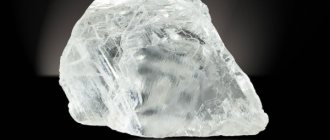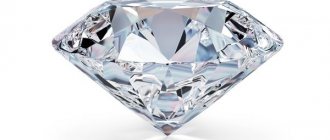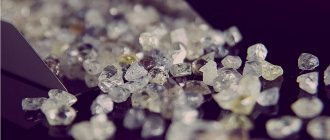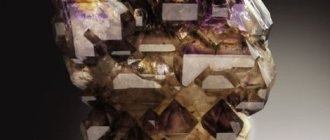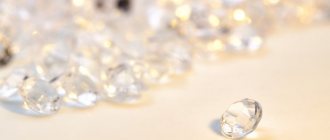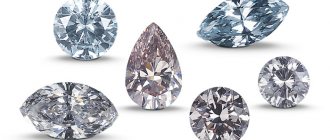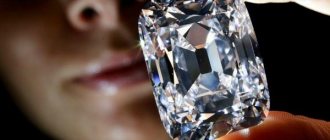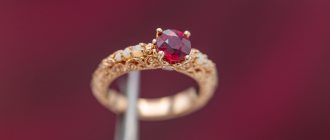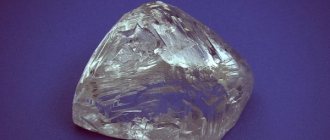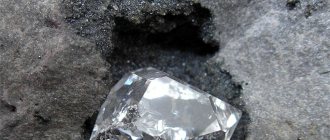Perhaps everyone knows that diamond is the hardest mineral on earth. Thanks to this characteristic, the gem is often used not only in the jewelry industry, but also in other areas where hardness is of high importance. Everyone is familiar with such concepts as “diamond sputtering”, “diamond chips” or “diamond drilling”. But why does the stone have such a high level of hardness, since it, like graphite, consists entirely of carbon? And graphite, as you know, has a completely opposite hardness rating, which is 1-2 on the Mohs scale.
Exchange.
You can exchange your damaged diamond for a new one at a jewelry store.
However, it is quite expensive. Since a chip is considered a flaw in the stone, its clarity rating will drop significantly. This means that the value of the diamond will decrease.
Therefore, if the jeweler agrees to an exchange, then you will be given a stone that costs less than what you paid for your original diamond. You can also get a better stone by paying extra money by selling your old one.
In any case, only make this choice if you are sure that your insurance company will not cover the damage.
Diamond Strength
Much has already been said about the strength of the most valuable stone. The mineral is almost impossible to split or crumble. Moreover, if you try to scratch the glass with a gem, it will leave a mark on it in the form of a scratch, but will not suffer at all. But is this really so?
Is it possible to break a diamond?
Of course, if you put a stone under a press and release the lever, the mineral will immediately crumble. But with minor impacts, you are unlikely to damage the structure of the gem? So is it possible to break a diamond? Of course you can. But here it’s not even a matter of the force of the blow, but the correctness of its direction.
For example, we can recall the story of the famous Cullinan diamond. It was simply impressive in size, because its weight was 3106.75 carats. This is just over 600 grams. So, when trying to make diamonds from the mineral, jewelers encountered difficulties, because splitting the gem was not so easy. But at some point, Joseph Ascher, the best lapidary of the time, who studied Cullinan, noticed a small crack on the surface of the stone. It was this minor defect that allowed Asher to figure out how to split the crystal. He put a chisel to the scratch and hit it with a hammer. The calculation turned out to be more than correct - the mineral split into two parts.
Thus, we can conclude that a diamond can still be broken if you correctly calculate the location of the impact and act on it in the right direction.
What's stronger than diamond
If we compare diamond with other natural minerals, there is nothing stronger than it. On the Mohs scale, it received the highest score - 10. Only corundum and topaz are only slightly inferior to it in this characteristic.
If we compare it with other crystalline substances, then the following are considered stronger than it:
- fullerite - molecular crystals that, during polymerization, are connected to each other by strong bonds similar to diamond ones;
- Gallium arsenide (GaAs) is a chemical compound of gallium and arsenic;
- elbor or borazon - has the same hardness rating (10 on the Mohs scale).
Of course, we should not forget that in modern science scientists are constantly discovering new alloys that are no less hard than diamond. But if we consider a stone solely as a precious stone (diamond), then there is nothing harder than it on planet Earth.
What is recutting and how can it help?
Recutting is simply the process by which a jeweler creates a smaller stone from a larger one. The name itself suggests that the diamond is cut again, part of it is removed and the stone is reduced in carat weight.
A lower carat weight means your diamond also becomes less valuable. How much your stone will lose in value will depend on how severe the damage is.
The larger the chip, the more diamond the jeweler will have to remove. Plus, recutting will cost you extra money.
If you don't want to pay more and the chip doesn't bother you too much, you can always leave it as is.
No matter what you do, always remember to handle your diamonds with care.
Why is diamond hard?
It is sometimes hard to imagine that soft black graphite and hard transparent diamond are made of the same atoms - carbon atoms. The properties of these minerals are so different only because they have different types of crystal lattices.
Thus, the crystal lattice of graphite contains layers that are weakly interconnected. Diamond consists of atoms that are very firmly connected to each other in all directions, which is what gives the gem such exceptional hardness.
Through the Diamond's Eye
But the most powerful “driller” for a diamond turned out to be a light beam.
Back in 1951, three Soviet scientists - V. A. Fabrikant, M. M. Vudynsky and F. A. Butaeva outlined in their author's application the idea of obtaining a powerful narrow beam of light. A year later, simultaneously in the USSR (scientists N.G. Basov and A.M. Prokhorov) and in the USA (C. Townes, J. Gordon, H. Zeiger and J. Weber) the principle of generating a narrow directional light beam was proposed. Such a beam is capable of transferring enormous energy. In 1959, N. G. Basov and A. M. Prokhorov were awarded the Lenin Prize, and in 1964 - the Nobel Prize for the development of molecular generators and amplifiers of such light rays - the famous lasers. The laser beam instantly burns through everything that gets in its way. Even the indestructible diamond is unable to resist him. Thus, a ray of light became a powerful human assistant in the manufacture of diamond dies.
The first experiments in drilling diamonds were crowned with phenomenal success. And this is not surprising: after all, the laser emits a light flux with a temperature of more than 50 thousand degrees (recall that the temperature of the surface layers of the Sun is only 6 thousand degrees). A laser light beam burns a tiny hole in the diamond, and this operation lasts 1/5000 of a second! 104 The most important thing is that the structure of the diamond does not change at all - the light “drill” burns through it so quickly.
Stefan Zweig, who wrote that “diamonds can be split or thrown away, but not drilled,” turned out to be wrong: today this operation is quite feasible.
A completely new branch of processing - light technology has opened up endless possibilities for processing not only diamonds, but also all hard, super-hard and brittle materials in general.
Thus, an electric spark, inaudible sound vibrations, a beam of electrons and, especially, the light spear of a laser became the destroyers of the indestructible.
Soviet Kvant-9 laser systems for making holes in diamonds and hard alloys have become widely known throughout the world.
The first quantum generator for the production of diamond dies was installed at the Roslavl Diamond Tools Plant. At this enterprise, the production of diamond dies using a laser is put on a conveyor belt. In two to three microseconds, a light beam burns a channel several microns in diameter in a diamond crystal. The main thing is done. Now all that remains is to turn the drilled diamond into a wire.
With the old method of making diamond dies, this operation required hundreds of hours, and large defects were inevitable: to get one good tool, you had to spend 4-6 diamonds. Previously long and painstaking work, today it lasts no more than 10-15 minutes (including adjusting the hole to the required diameter) - this is about 800 times faster!
The laser beam instantly burns through the diamond crystal
Yakut Brazil
The dissolution of diamonds is accompanied by the appearance of flaws of various shapes on their surface.
Few owners of diamond jewelry think about what type of crystal lattice their diamonds have - cubic, 8-sided octahedrons, 12-sided or even 24-sided. The shape of the crystals does not affect the consumer properties of diamonds - both of them sparkle and shimmer. But for mineralogists, the question of different crystal shapes is fundamental.
The scientific name for 12-sided diamond crystals is curved dodecahedroids. Before the discovery of kimberlite pipes at the end of the 19th century, diamonds were mined from placers, first Indian, then Brazilian. Based on the location of the main find, the curved dodecahedroids were called “Brazilian” type diamonds. Later they were found in open industrial placers of the Urals and Northern Yakutia, in the basins of the Anabar and Olenek rivers and further to the east - in the lower reaches of the Lena. Now these diamonds can be found in specialized literature under a different name - “Ural” type diamonds.
They have 12 faces in the form of rhombic pads, which have a spherical convex shape. Another feature is that each of the rhombic faces is refracted along a short diagonal of the rhombus, which is clearly visible in the photograph of a typical dodecahedroid [ - page 29].
Diamond cut by nature
The first researchers of dodecahedral crystals were the outstanding Russian geochemist, and then a graduate student at the University of Heidelberg, Alexander Fersman and his supervisor Viktor Goldshmidt. In 1911 they published a major monographic work, Der Diamant.
Having studied a huge number of crystals and the smallest details of their morphology, the authors came to the conclusion that such rounded individuals are the result of surface dissolution of previously normally developing flat-faced forms of diamond crystals - octahedra and cubes, and even supplemented these conclusions with experiments on chemical etching of diamonds in potassium nitrate at temperature 800-900°C. However, this did not prevent a debate about the origin of round diamond crystals from flaring up in the 1950s, which lasted for half a century. Opponents again discussed whether diamond crystals acquired this shape due to growth or dissolution. Alexander Khokhryakov and Yuri Palyanov from Novosibirsk put an end to the dispute.
In the early 1990s, in their laboratory they simulated the processes occurring in the Earth's mantle at ultra-high pressures and temperatures (25-55 kbar and 1370-1720 K), and dissolved diamonds in water-containing silicate melts. The resulting crystals were almost completely similar to natural round diamonds - curved dodecahedroids [Fig. ].
We were able to trace the entire series of transitions from a full-fledged cubic crystal to a rounded tetrahexahedroid in diamonds from the Anabar River placers. They are approximately the same size, but in nature or the laboratory, in order for the crystal to reach the shape of a full-fledged dodecahedroid, up to 80% of its original volume dissolves.
Diamond surgery
Inclusions of other minerals can be found in diamonds. If they are similar in shape to the crystals of the host diamond, then, with a high probability, they were formed simultaneously with the diamond. Such inclusions are called syngenetic. Benchmarks of extremely high temperatures and pressures during diamond nucleation are inclusions of high-density crystalline modifications of silica - stishovite and coesite.
Scheme: Mila Silenina
Garnet, olivine, pyroxene, graphite, sulfides, many other minerals and even gas-liquid inclusions are often found in diamonds []. The chemistry of prisoner minerals and their associations provides information about the history of the Earth's mantle.
Inclusions are removed by splitting the diamond, sawing, grinding or simply burning it. Diamond burns easily at a temperature of 850-1000° C. The remaining ash can also tell a lot. Using isotope dating of ash residues, the age of syngenetic inclusions and, consequently, of the diamonds themselves was determined. This age ranges from 1.5 to 3.5 billion years. Young diamonds are hundreds of millions of years old.
Recently, increasing attention has been paid to the isotopic composition of carbon in diamond—the ratio of heavy (mantle) 13C and light (crustal) 12C isotopes. The presence in diamonds of light isotopes characteristic of organic compounds has given rise to a surge of hypotheses about its source and sparked discussions about the migration of carbon in the mantle and crust during the movement of continental and oceanic plates. Based on these data, planetary models of degassing of the Earth’s core during its evolution are constructed. They are involved even when discussing the controversial issue of the origin - organic or inorganic - of oil and natural gas.
Many people think that the best way to distinguish imitation diamonds from real stones is to cut them into the glass. However, everything is not so simple. Diamond does cut glass, but the fact is that glass and its four synthetic analogues, which are often passed off as diamonds, cut in the same way. Therefore, the simplest diagnostic method is to place the stone without a rim on a black, preferably polished, surface with the base down and the tenon up. In this case, the imitation seems to go out and stop playing, since it allows light to pass through. And diamonds remain diamonds. But, of course, it is best to have a professional determine the authenticity of the stones.
Diamonds have long been considered, and are still considered by some today, to be indestructible. Previously, it was even argued that the anvil would rather go into the ground than break a diamond. True, there were those who questioned such statements. For example, the famous naturalist Pliny was sure that a diamond could be broken if it was soaked in the blood of a goat. And the medieval natural scientist and philosopher Albert the Great (about 1193–1280) clarified: before bleeding a goat, it should be fed with parsley and given wine to drink. In reality, diamond is fragile, just like most other hard minerals. Breaking a diamond with a hammer is not at all difficult, and sometimes it is enough to hit it unsuccessfully on something.
See also: Interesting facts about diving. History of extreme hobbies
As for the chests full of diamonds that were found by some fairy-tale and literary heroes, Ludwig Soucek writes about this: “Diamond did not adorn the treasuries of Ali Baba, the fabulously rich khans and viziers. Opening their iron-forged chests, the admiring spectator did not admire the cold diamond shine: until the middle of the 15th century, diamonds were set into jewelry in their raw form, as rather shiny, but not very beautiful stones, because, unlike other precious stones, diamonds resisted processing . The ability to polish these stones with diamond powder was discovered in the mid-15th century by Ludwig van Berkwem from Antwerp. This was only the first step, the work was incredibly difficult and painstaking, so the first diamond ordered by Cardinal Mazarin was seen by the world only in 1660.”
Ludwig Soucek also notes the fact that one cannot equate a diamond with a diamond. A diamond usually means a cut, polished diamond, but white sapphire, crystal, and even ordinary glass can be cut in exactly the same way.
See also: What sea signs you need to know on land
“The Complete Encyclopedia of Our Misconceptions”, S. A. Mazurkevich
From here: foolya.ru
If you find an error, please select a piece of text and press Ctrl+Enter.
